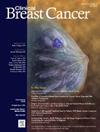Perceptions of Delayed Alopecia Among Breast Cancer Survivors
IF 2.9
3区 医学
Q2 ONCOLOGY
引用次数: 0
Abstract
Background
Retrospective studies suggest that some breast cancer survivors report treatment-associated hair loss or thinning years after their diagnosis. This study investigates frequency and perceptions of alopecia persisting 6 years after patients’ breast cancer diagnoses.
Methods
Breast cancer survivors participating in the Mayo Clinic Breast Disease Registry (MCBDR) were mailed a survey 6 years after diagnosis. They were asked about their degree of bother from hair thinning and hair loss and mental health was explored.
Results
A total of 969 of 1476 participants (65.7%) responded to the survey. Of these, 755 patients were eligible for inclusion and had stage I-III breast cancer. Respondents' median age was 65.6 years (35-95 years). Chemotherapy (± endocrine therapy) was administered to 216 (29%) participants, and 342 (45%) received only endocrine therapy. Nearly half (345, 46%) of respondents reported hair loss and over half (431, 57%) reported hair thinning. Moderate to extreme bother from hair loss was reported by 27% of chemotherapy recipients, by 18% of endocrine therapy only recipients, and by 14% of patients who received neither. Moderate to extreme bother from hair thinning was reported by 31% of chemotherapy recipients, by 21% of endocrine therapy-only recipients, and by 19% of those who had received neither. Hair growth product usage was reported by 31% of chemotherapy recipients and 14% of endocrine therapy-only recipients.
Conclusions
Hair loss and thinning are frequently reported as persistently bothersome symptoms by breast cancer survivors. Future investigations into the incidence, predictors, and treatment of therapy-associated alopecia are needed.
乳腺癌幸存者对延迟性脱发的看法。
背景:回顾性研究表明,一些乳腺癌幸存者在确诊多年后仍会出现与治疗相关的脱发或头发稀疏现象。本研究调查了乳腺癌患者确诊 6 年后持续脱发的频率和看法:参加梅奥诊所乳腺疾病登记处(MCBDR)的乳腺癌幸存者在确诊 6 年后收到了一份调查邮件。他们被问及头发稀疏和脱发的困扰程度,并对心理健康进行了调查:结果:1476 名参与者中共有 969 人(65.7%)回复了调查。其中,755 名患者符合纳入调查的条件,并患有 I-III 期乳腺癌。受访者的中位年龄为 65.6 岁(35-95 岁)。216人(29%)接受了化疗(含内分泌治疗),342人(45%)仅接受了内分泌治疗。近一半的受访者(345人,46%)报告脱发,超过一半的受访者(431人,57%)报告头发稀疏。27%的化疗患者、18%的仅接受内分泌治疗的患者以及14%的两者均未接受内分泌治疗的患者都报告了因脱发而造成的中度至极度困扰。31%的化疗患者、21%的仅接受内分泌治疗的患者以及 19% 的两者均未接受内分泌治疗的患者报告了中度至极度的头发稀疏困扰。31%的化疗受试者和14%的仅接受内分泌治疗的受试者表示使用了生发产品:结论:脱发和头发稀疏是乳腺癌幸存者经常报告的持续困扰症状。今后需要对治疗相关性脱发的发生率、预测因素和治疗方法进行调查。
本文章由计算机程序翻译,如有差异,请以英文原文为准。
求助全文
约1分钟内获得全文
求助全文
来源期刊

Clinical breast cancer
医学-肿瘤学
CiteScore
5.40
自引率
3.20%
发文量
174
审稿时长
48 days
期刊介绍:
Clinical Breast Cancer is a peer-reviewed bimonthly journal that publishes original articles describing various aspects of clinical and translational research of breast cancer. Clinical Breast Cancer is devoted to articles on detection, diagnosis, prevention, and treatment of breast cancer. The main emphasis is on recent scientific developments in all areas related to breast cancer. Specific areas of interest include clinical research reports from various therapeutic modalities, cancer genetics, drug sensitivity and resistance, novel imaging, tumor genomics, biomarkers, and chemoprevention strategies.
 求助内容:
求助内容: 应助结果提醒方式:
应助结果提醒方式:


